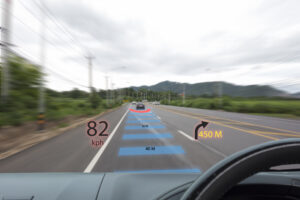While technology continues to seep into various aspects of our lives and becomes more and more advanced, the motor vehicle industry has certainly not been left behind.
With an array of new features being added to our cars every year, from parking sensors and reverse cameras to wifi hotspots and AI led safety systems, the head-up display is one of the latest vehicle add-ons which could become standard practice among car manufacturers in the near future.
What is a head-up display?
Often referred to as a HUD, a head-up display is a piece of technology capable of displaying a digital projection of essential driver information into the driver’s line of sight, typically directly on to the windscreen. It basically works on the principles of augmented reality and gives the effect of the information being displayed on the road in real time.
Pretty cool, right?
This information may include that which would otherwise be found on the dashboard and would usually require the driver to look downwards to find – such as the vehicle speed, navigational information or even engine warning lights.
The idea behind HUDs is that they have been specifically designed and positioned to allow drivers to easily process essential information without drawing their attention from the road.
Types of HUDs
There are 2 main types of HUDs found in vehicles today. Both use a projector, but the way the information is displayed differs.

Internal windscreen projector HUDs
Firstly, there are several upmarket luxury vehicles including the BMW 7 Series, Land Rover, Mercedes Benz C-Class and the Lexus RX which have a projector built into the dashboard that displays the information directly onto the drivers windscreen.
The amount of information displayed can vary, with the vehicle’s speed being displayed as standard. Other cool capabilities include displaying arrows on the road to indicate which turn the driver needs to take, and also highlighting potentially important road signs and signals. Sometimes it is even possible to customize the level of information displayed and even change the colour scheme of the display.
Seriously, some of these HUDs look like something out of a James Bond movie.
With this type of HUD technology, a special type of windscreen glass must be used in order to ensure the information can be projected efficiently. This means they’re gonna cost more than other HUD systems and if you happen to crack, chip or smash your windscreen, it may cost more to replace than a standard windscreen.
Combiner screen projector HUDs
The other most common type of HUD uses a small transparent screen built into the dash, commonly referred to as a ‘combiner system’. This small screen often rises from the dash and will retract back down into the dash when not in use.
The screen is designed to be unnoticeable when not being directly looked, so it does not distract the driver while driving.
Since it’s a smaller surface area, typically less information will be displayed on such HUDs as there simply isn’t the space, meaning it’s also unlikely that the display itself will be any way customizable. On the upside, in the case of a chipped, cracked or smashed windscreen, the cost of repairs will be lowered as only standard glass will be required.
One might find a retractable HUD screen in car models such as the Mazda 3, MINI Cooper and Ford Focus.
Do I need a HUD in my car?
Although not completely necessary, HUDs are an awesome feature for any driver to have in their vehicle. Their main benefit of minimizing drivers distractions is definitely of benefit, and if nothing else – they look pretty damn cool.
Since it’s likely that HUDs will become standard in all vehicles in the future, maybe it’s best to get ahead of the curve and get one in your vehicle now. As long as you can afford the extra cost of the add-on and the potential extra expense involved in repairing the windscreen if that’s where the info is displayed, I don’t see why you wouldn’t choose to have one!
